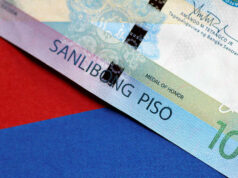Banks show bigger returns in Q2 despite slower asset growth
By Jochebed B. Gonzales, Senior Researcher
THE COUNTRY’s biggest banks were more profitable in the second quarter even as growth in assets slowed and their capacity to absorb risky assets dipped.
The second quarter edition of BusinessWorld’s Quarterly Banking Report showed the combined assets of the 43 universal and commercial banks (UK/Bs) operating in the country rose 9.85% to P15.39 trillion from P14.01 trillion recorded in the same three months last year.
The asset growth pace seen in the April-June period was slower than the 10.97% logged in the preceding quarter and 13.93% in April-June 2017. This also snapped a two-year streak of double-digit growth in assets.
Money lent by banks in the form of loans and receivables totaled P8.41 trillion by the end of the first half, 18.18% more than the P7.12 trillion in the same period last year.
In terms of profitability, the median return on equity (RoE) of U/KBs improved to 6.38% last quarter from 5.09% in the first quarter and 4.70% in 2017’s second quarter. RoE, which is the ratio of net profit to average capital, measures the amount that shareholders make on every peso invested in a company.
In terms of assets, BDO Unibank, Inc. (BDO) remains at the top, followed by Metropolitan Bank & Trust Co. (Metrobank) and the Bank of the Philippine Islands (BPI). They are also the banks that issued the most loans during the quarter, also in that order.

Among banks with assets of at least P100 billion, Robinsons Bank Corp. topped in terms of growth, increasing 24.79% year-on-year. It was followed by China Banking Corp.’s 17.06% and the Development Bank of the Philippines’ 15.73% increases.
The same three months saw Robinsons Bank as the most aggressive lender, with a year-on-year growth of 42.05%, followed by those of Land Bank of the Philippines (35.67%) and Asia United Bank Corp. (26.22%)
Meanwhile, Metrobank displaced BPI at second place in terms of deposits,with the former having P1.56 trillion and the latter, P1.54 trillion. Both, however, trailed behind BDO’s P2.32-billion deposit base.
ASSET QUALITY
Meanwhile, the banks’ ability to absorb losses from risk-weighted assets eroded as their median capital adequacy ratio (CAR) — a measure of a bank’s solvency — dipped to 17.29% from the 18.19% seen in the preceding three months. Nevertheless, the ratio remains well above the regulatory minimum of 10% set by the Bangko Sentral ng Pilipinas as well as the international standard of eight percent.
The nonperforming loan (NPL) ratio of the biggest banks improved to 1.5% in the second quarter compared to the first quarter’s 1.57%.
Their nonperforming assets (NPA) ratio — the combination of nonperforming loans, foreclosed properties and total assets — edged up to 0.66% from 0.61% three months prior.
As percent of total assets, foreclosed real and other properties fell to 0.34% from 0.35%.
Banks’ coverage ratio — which is the ratio of the total loan loss reserves to gross NPL — was 143.6% during the quarter. This was lower than 152.84% recorded in the preceding three months, but still more than enough to cover the entire value of bad loans held by big banks, with loan loss reserves totaling some P158.827 billion.
BusinessWorld Research has been tracking the financial performance of the country’s U/KBs on a quarterly basis since the late 1980s using banks’ published statements of condition.



